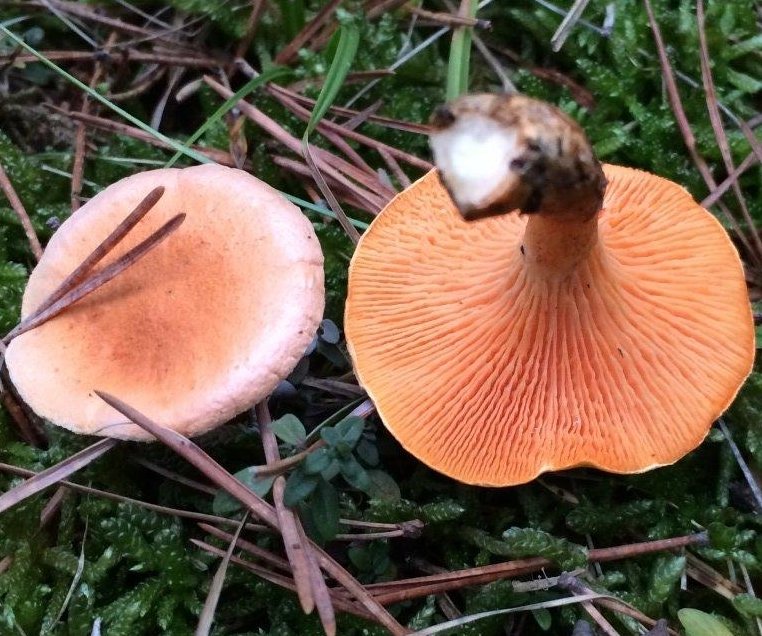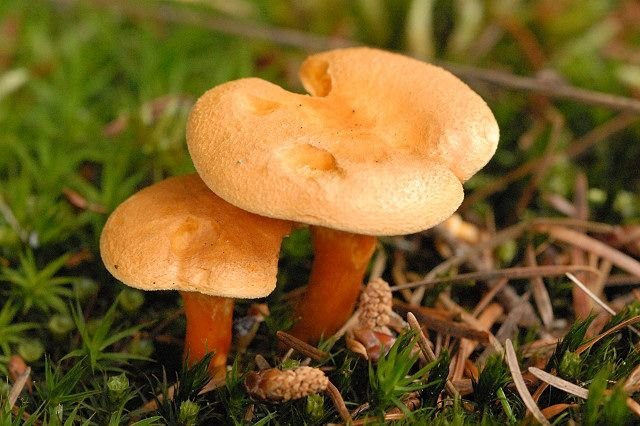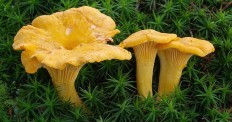Contents
Chanterelle false (Hygrophoropsis aurantiaca)
- Division: Basidiomycota (Basidiomycetes)
- Subdivision: Agaricomycotina (Agaricomycetes)
- Class: Agaricomycetes (Agaricomycetes)
- Subclass: Agaricomycetidae (Agaricomycetes)
- Order: Boletales (Boletales)
- Family: Hygrophoropsidaceae (Hygrophoropsis)
- Genus: Hygrophoropsis (Hygrophoropsis)
- Type: Hygrophoropsis aurantiaca (False chanterelle)
- Orange talker
- Kokoschka
- Hygrophoropsis orange
- Kokoschka
- Agaricus aurantiacus
- Merulius aurantiacus
- Cantharellus aurantiacus
- Clitocybe aurantiaca
- Agaricus alectorolophoides
- Agaricus subcantharellus
- Cantharellus brachypodus
- Chantharellus ravenelii
- Merulius brachypods

head: with a diameter of 2-5 centimeters, under good conditions – up to 10 centimeters, at first convex, with a folded or strongly curved edge, then flat-prostrate, depressed, funnel-shaped with age, with a curved thin edge, often wavy. The surface is finely velvety, dry, velvety disappears with age. The skin of the cap is orange, yellow-orange, orange-brown, darkest in the center, sometimes visible in faint concentric zones that disappear with age. The edge is light, pale yellowish, fading to almost white.
plates: frequent, thick, without plates, but with numerous branches. Strongly descending. Yellow-orange, brighter than caps, turn brown when pressed.
Leg: 3-6 centimeters long and up to 1 cm in diameter, cylindrical or slightly narrowed towards the base, yellow-orange, brighter than the cap, the same color as the plates, sometimes brownish at the base. May be curved at the base. In young mushrooms, it is whole, with age it is hollow.
Pulp: thick in the center of the cap, thin towards the edges. Dense, somewhat cottony with age, yellow, yellowish, pale orange. The leg is dense, hard, reddish.

Smell: weak.
Taste: Described as slightly unpleasant, barely distinguishable.
Spore powder: white.
Споры: 5-7.5 x 3-4.5 µm, elliptical, smooth.
The false chanterelle lives from the beginning of August to the end of October (massively from mid-August to the last ten days of September) in coniferous and mixed forests, on soil, litter, in moss, on rotting pine wood and near it, sometimes near anthills, singly and in large groups, quite often every year.
Distributed throughout the temperate forest zone of Europe and Asia.


Common chanterelle (Cantharellus cibarius)
with which the false chanterelle intersects in terms of fruiting time and habitat. It is easily distinguished by a thin dense (in real chanterelles – fleshy and brittle) texture, a brighter orange color of the plates and legs.

Red false chanterelle (Hygrophoropsis rufa)
distinguished by the presence of pronounced scales on the cap and a more brown central part of the cap.
Chanterelle false for a long time was considered a poisonous mushroom. Then it was transferred to the category of “conditionally edible”. Now many mycologists tend to consider it rather slightly poisonous than edible, even after preliminary boiling for at least 15 minutes. While physicians and mycologists have not come to a consensus on this matter, we recommend that people with hypersensitivity to mushrooms refrain from eating this mushroom: there is information that the use of false chanterelle can cause an exacerbation of gastroenteritis.
Yes, and the taste of this mushroom is much inferior to the real chanterelle: the legs are hard, and the old hats are completely tasteless, cotton-rubber. Sometimes they have an unpleasant aftertaste from pine wood.
Video about mushroom Chanterelle false:
The article uses photos from questions in recognition: Valdis, Sergey, Francisco, Sergey, Andrey.









